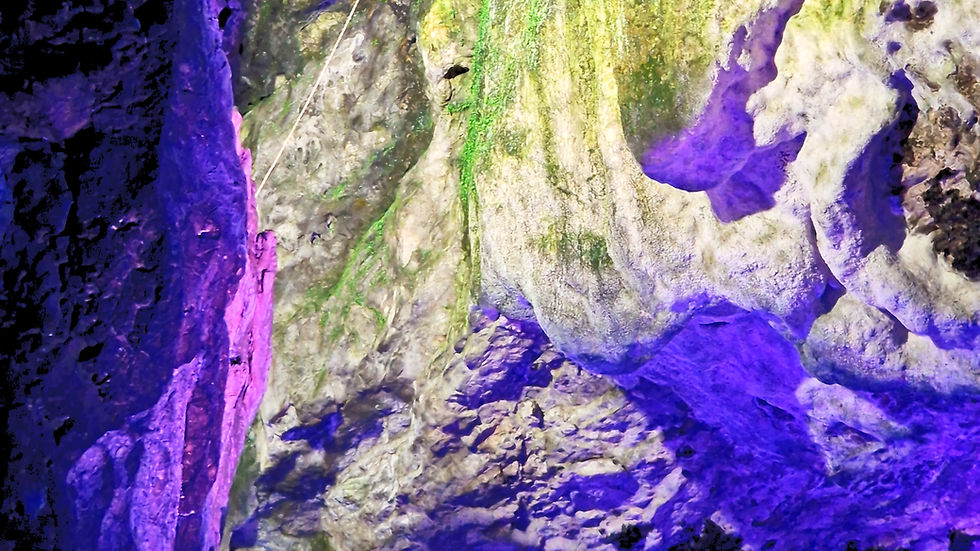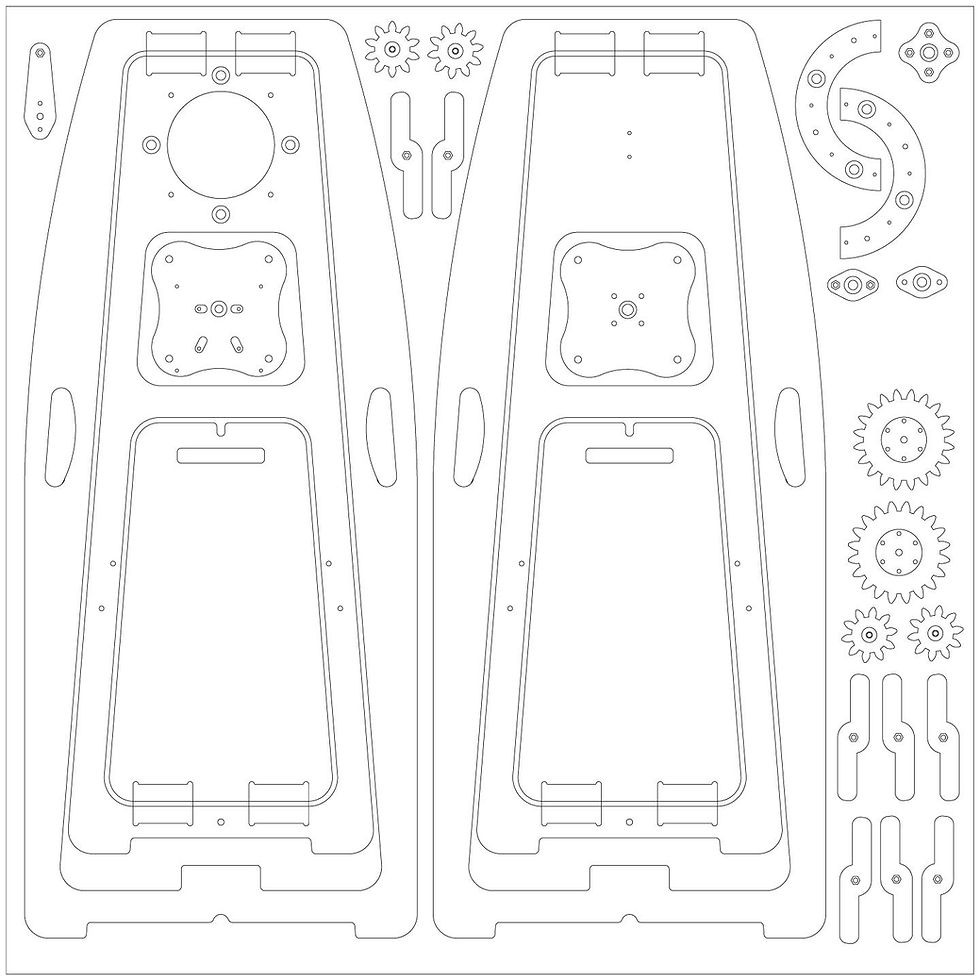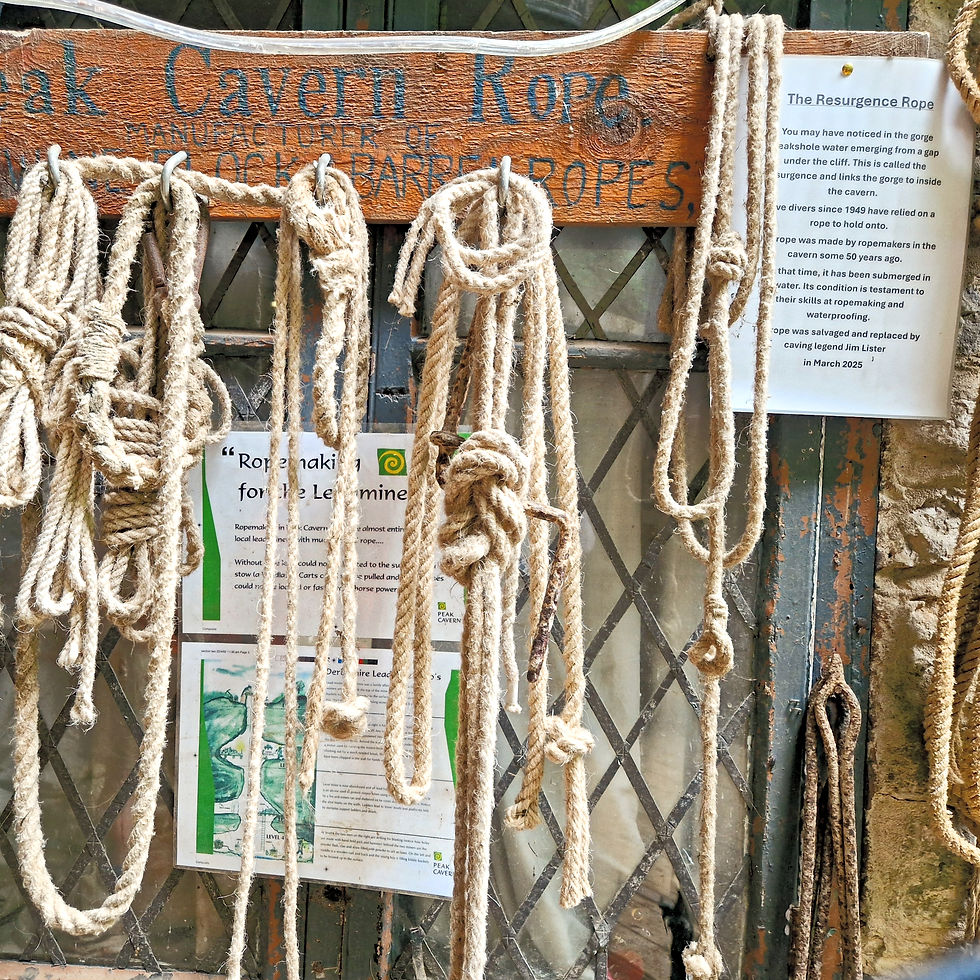Rope & Flax Cave Artistry: Contemporary Community Textile Derbyshire
- amanda haran

- Jun 4
- 5 min read
Updated: Jun 8
Waingroves & Wayne Do The Devil's Arse - How Do You Make Rope?

My contemporary community textile artist Derbyshire's 'excellent adventure' into all things flax had begun unexpectedly at a nearby place called the Ropewalk on the former site of Waingroves Pit, a long straight nothing of a path really, without even a mention on a modern map. From this encounter (eventually) came my front garden and many waking (and sometimes dreaming) hours to be completely taken over by a flax crop.
Little did I know that this germination and growing gamble would lead me to a gallantly named place called the Devil's Arse, where I would be guided by the fantastic Wayne on the history and nuances of rope making before industrial mechanisation, essentially how it would have been carried out at the rope walk—the Wain: Wayne connection and synergy was not lost on me.
NAUGHTY NOTE: The Devil's Arse is more formally known as Peak Cavern. Legend has it that the name was altered during a royal visit from Queen Victoria, as organisers felt the original title might be a bit too risqué for the occasion! I feel duty-bound to address the cave as its community intended. Therefore, the Devil's Arse shall remain its name throughout this post. I'm a stickler for community power!
Home Of The Rope Makers

So, back to the Devil's Arse and rope making...located in Castleton, Derbyshire, it has been the backdrop for countless shows, concerts, events and films, all thanks to its atmospheric chambers and incredible acoustics. Yet, the traditional community rope-making story truly made this magical place come alive for me. I couldn't ignore the tiny one-room rock-chiselled houses that once were the homes for families of ropemakers from the mid-1600s to the mid-20th century. It beggars belief how grandma and grandad, right through to an entire brood of grandchildren, squashed into these small dwellings, let alone sleep, eat and procreate! But they did, and their rope-making generational skills were very sought after.
It didn't organically compute why people created rope (and lived) in a set of damp, cold, dark caves when all the rope walks I had known were outdoors, straight and near where the products were to be used. I smugly thought (putting on my textile degree mortarboard at a jaunty angle) that it must have something to do with temperature and humidity (a case of overthinking I was to find, as it was merely financial.)
Rope making actually kicked off at the Devil's Arse because the cave's wide, sheltered entrance was perfect for working in all sorts of weather—a fact that the ever-present despot quickly noticed. In the mid-1600s, the then-manager, William Baxter, decided to move operations into the cave. He spotted a chance to boost production, even with Derbyshire's famously dodgy weather. By bringing his workers inside, he could keep making rope all year round, use the vast depths of the cave to make super-long ropes and protect his profits: win-win-win. While it was a practical move, it also showed how businesses could (and still do) take advantage of the natural landscape for profit; here, it was at the expense of the workers' comfort and daylight. Rope-making continued in the cave until 1914, when it shut down due to the outbreak of the First World War, although demonstrations of rope-making carried on into the 20th century.
Is Wayne The Ultimate Contemporary Community Textile Artist, Derbyshire?

Remember Wayne, our gregarious guide? Wayne shared the art of rope-making in super generous dollops. It all starts with fibres—and today, they use flax sourced from the Chatham Dockyards in Kent. That little detail gave me such heartfelt joy: the very flax I cherish and cultivate in my Derbyshire garden has relations that are playing a role in this beautiful traditional craft once again.
The rope-making machine Wayne showcased was simply amazing for a flax fan of G.O.A.T. credentials.
Before the age of full mechanisation and industrialisation, rope-making was a dance of the hands and feet. The operator would walk the length of the rope walk, hand gliding along the taut fibres, feeling them twist and strengthen beneath their fingers. It was strangely meditative—repetitive yet responsive, as if they were physically coaxing the fibres into unity. That hand-to-fibre connection offered something awe-inspiring: a tangible, rhythmic bond to generations of makers who worked not with machines but with instinct, muscle memory, and a deep respect for the material. Several strands of flax fibre are twisted together, and tension is carefully maintained until the fibres become stronger as one. Watching it felt like seeing a metaphor for community itself: individual strands becoming something powerful together. The process reminded me so much of spinning and processing flax in my own work—that same mix of rhythm, tension, patience and touch.
Weaving & Rotating Connections
As someone who runs a community flax textile project in Derbyshire, this visit was incredibly inspiring. My work isn't solely about creating with flax; it's about weaving connections between people, our local heritage, sustainable practices, and one another. Suddenly, rope, which is often overlooked in textiles, has taken on new life and significance for me.

After the visit, I stumbled upon a brilliant open-source rope-making machine designed by Sanne Visser. It's thoughtfully created with sustainability in mind; I have put it out to the universe to one day build this beauty. The intention is for this machine to introduce rope-making into our community project, adding another exciting layer of creativity and historical exploration.
SPOILER: I later visited the Museum of Making in Derby, saw their rope-making machine, which isn't on display at the moment, and visited their workshop. Their peeps here believe it's soooo possible; I even saw the big piece of kit that they would use. The universe is giving quickly this time.
My day at the Devil's Arse has lingered in my heart. From Wayne's expert insights to the tactile experience of flax rope in hands to echo rope makers who came before us, I am reminded that my journey as a contemporary community textile artist in Derbyshire is interwoven with stories, skills, and shared inspiration.

I cherish every twist in this vibrant thread!
Tags: contemporary community textile artist Derbyshire, flax, rope making, heritage craft, Sanne Visser, Peak Cavern, Devil's Arse, sustainable textiles, community art, Waingroves Colliery












